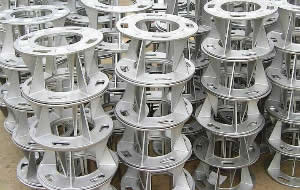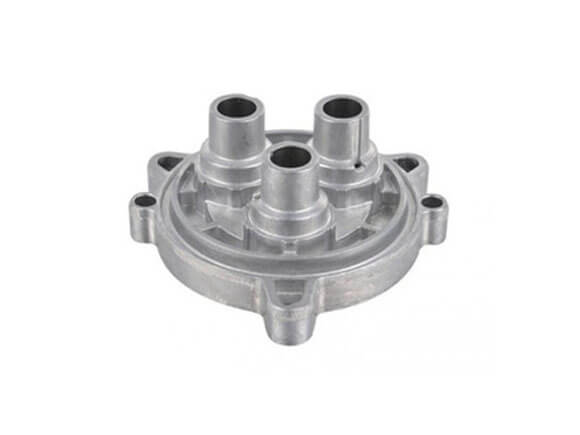Comprehending Aluminum Casting: A Comprehensive Overview to Its Applications and benefits
Aluminum casting is a process that changes molten aluminum into strong kinds through numerous methods. This approach supplies notable advantages, such as light-weight toughness and rust resistance. It locates applications in countless markets, mirroring its adaptability. Nonetheless, recognizing the intricacies of aluminum casting and its ideal methods can considerably impact the high quality of the end product. Checking out these aspects discloses truth capacity of aluminum casting in modern manufacturing.
The Basics of Aluminum Casting
Aluminum casting is a production process that changes molten aluminum right into solid items via different techniques. This process starts with heating aluminum up until it reaches its melting factor, allowing it to stream right into molds. There are numerous approaches of aluminum casting, consisting of sand casting, die casting, and investment casting, each appropriate for various applications based upon design intricacy and manufacturing quantity.
In sand casting, molds are formed making use of sand, providing versatility for detailed forms. Pass away casting involves forcing molten aluminum into a steel mold and mildew under high pressure, causing repeatable and exact parts. Financial investment casting, on the various other hand, utilizes a wax pattern that is covered with ceramic to create detailed parts.
After the aluminum cools down and solidifies, the molds are gotten rid of, disclosing the ended up products. This casting process is important in numerous industries, consisting of vehicle, aerospace, and durable goods, allowing the development of long lasting and lightweight parts.
Benefits of Aluminum Casting
Among the crucial benefits of aluminum casting hinges on its capability to generate light-weight yet strong parts. This special combination makes aluminum an optimal selection for different industries, consisting of auto, aerospace, and consumer goods. The intrinsic rust resistance of aluminum additionally boosts the resilience of the cast elements, extending their life-span and decreasing the need for maintenance.
Furthermore, aluminum casting allows for detailed styles and intricate geometries, which can result in much more effective and visually pleasing products. The material's excellent thermal and electric conductivity better increases its applications, especially in electronic devices and heat exchangers.
Aluminum recycling is very reliable, contributing to ecological sustainability and lowering production prices. Generally, the advantages of aluminum casting setting it as a sensible and functional remedy for manufacturers looking for to maximize efficiency while reducing weight and resource usage.
Typical Approaches of Aluminum Casting
While different strategies exist for aluminum casting, each method supplies distinct benefits tailored to particular applications. The most typical techniques consist of sand casting, pass away casting, and financial investment casting.
Sand casting, understood for its flexibility, utilizes sand molds to create complicated forms and is suitable for both large and small manufacturing runs. Die casting, on the various other hand, employs high-pressure injection of molten aluminum into steel molds, causing precise dimensions and smooth surfaces, making it suitable for automation.
Financial investment casting, usually referred to as lost-wax casting, includes producing a wax pattern coated with a ceramic covering. Precision aluminum casting. When the wax is thawed away, liquified aluminum is poured right into the tooth cavity, yielding complex styles and outstanding surface area coatings
Each of these methods plays an essential role in the aluminum casting landscape, supplying details benefits that cater to differing manufacturing needs and production scales.
Applications Throughout Industries
The flexibility of aluminum casting approaches permits a variety of applications across different sectors. In the automotive field, lightweight aluminum parts boost gas efficiency and performance, contributing to the expanding need for electrical automobiles. Aerospace industries make use of aluminum spreadings for their strength-to-weight proportion, guaranteeing safety and security and longevity in aircraft manufacturing.
The building market advantages from aluminum casting via building components and structural components that stand up to deterioration and call for very little upkeep. In addition, consumer electronics makers employ aluminum spreadings for structures and housings, stabilizing aesthetics with capability.
In the marine field, aluminum spreadings are favored for watercrafts and aquatic equipment because of their resistance to saltwater deterioration. The medical field utilizes aluminum spreadings in surgical tools and devices, sites making sure precision and integrity. Generally, aluminum casting's flexibility allows it to meet the varied needs of several fields, making it an have a peek at these guys essential production procedure.
Ideal Practices for Successful Aluminum Casting
Successful aluminum casting depends on a mix of careful preparation, accurate implementation, and extensive quality control. Selecting premium aluminum alloys is vital, as they straight affect the casting's residential or commercial properties and performance. Appropriate mold style is critical, guaranteeing that it suits thermal tightening and minimizes defects.
During the melting procedure, keeping the correct temperature level and preventing contamination are essential to attaining a consistent alloy. In addition, making use of reliable pouring techniques can boost the filling of molds, decreasing the chance of air pockets or inclusions.
Post-casting, carrying out extensive evaluation techniques, such as aesthetic analyses and non-destructive testing, guarantees that defects are recognized early. Employing strenuous quality control steps throughout the process helps keep uniformity and dependability in the final products. By adhering to these ideal methods, producers can significantly improve the success and effectiveness of their aluminum casting procedures.
Frequently Asked Questions
What Safety and security Actions Should Be Taken During Aluminum Casting?

Just How Can Defects in Aluminum Castings Be Reduced?
Flaws in aluminum spreadings can be decreased through cautious mold layout, correct temperature level control, making certain clean metal, making use of suitable putting methods, and performing comprehensive examinations to recognize and deal with concerns prior to completing the casting process.

What Is the Environmental Effect of Aluminum Casting?
The environmental impact of aluminum casting consists of energy-intensive procedures, greenhouse gas discharges, and source removal worries. Advancements in recycling and sustainable techniques can minimize these results, advertising a much more eco-friendly approach to aluminum production.
Can Aluminum Casting Be Reused?
Yes, aluminum casting can be reused effectively. The recycling process requires considerably less power contrasted to main aluminum production, making it an eco-friendly choice that adds to source conservation and decreased carbon discharges.
What Are the Prices Related To Aluminum Casting Processes?
Prices connected with aluminum casting procedures consist of material costs, labor, devices upkeep, energy consumption, and mold fabrication. These elements can vary considerably based on manufacturing range, intricacy of designs, and specific manufacturing methods used.
Aluminum casting is a procedure that transforms molten aluminum right into strong kinds via numerous techniques. Aluminum casting is a you can check here manufacturing process that transforms liquified aluminum right into solid things with different methods. While various methods exist for aluminum casting, each approach uses distinct benefits customized to certain applications. The ecological influence of aluminum casting consists of energy-intensive processes, greenhouse gas exhausts, and resource removal problems. Expenses associated with aluminum casting procedures include product expenses, labor, equipment upkeep, energy usage, and mold construction.